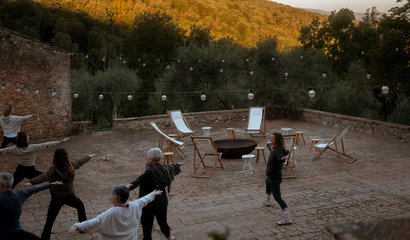Nov. 29, 2017
Yoga for Tight Psoas Muscles
What are the psoas muscles? How can we stretch the psoas to relieve tension and tightness?
What is the psoas muscle?
Your psoas (pronounced so-az) is a fascinating muscle. In fact, there are two of them! Emerging from each side of your lumbar spine and running down the front of your pelvis, over the ball and socket hip joints and connects into the lesser trochanter of the femur bones. It is a deeply embedded muscle, one that is hard to tangibly feel and sense. Which might be why there is such an air of mystery about it!

The psoas does so much for us as it is the only muscle that connects your spine to your legs. Not only just a muscle, the lumbar nerve plexus is embedded within the psoas, which means it is intimately tied with the nerves that deal with your pelvic floor, hip rotators, deep groin and inner thighs as well as the autonomic, motor and sensory fibers to your lower extremities.
The Psoas and Your Posture
While the psoas does so much for us, you could even say it does too much. How? Well, the short story is that your body adapts to the positions you spend the most time in. The majority of people sit most of the day and sit in a fairly fixed position at the computer, in the car and on the couch.
What about standing? Because of all that sitting, your psoas will be short and tight. This means when you stand, the tight psoas will do all sorts of fun things to your pelvis, legs and back. It might thrust the pelvis forward, taking your posterior leg muscles (your butt and hamstrings) out of the equation while potentially decreasing hip range of motion and strain your low back.

When we don't properly stack our bones and align the skeleton, we end up using muscles to hold us up. And one muscle that ends up doing most of the holding is your psoas.
When you use your psoas to do most of the heavy lifting of holding your skeleton up, it overworks a muscle that is there to respond, not to hold. This creates muscular fatigue, lack of blood and oxygen flow to many regions of your body. This affects your digestion, immune system and pelvic floor.
Now I don't want to get all doom and gloom here. I want us all to have a happy, supple and relaxed psoas. Now that you have a clearer picture of some of the lifestyle and postural factors that can contribute to a tight psoas, bringing attention throughout the day and the activities you are doing (including your yoga practice) can go a long a long way into putting some love back into your new friend, your psoas.
While there are a whole bunch of things we can do to support and release the psoas, one of the best ways to stretch your psoas is with a lunge. But not just your average lunge! Watch the video for a "move + learn" class where you'll learn about your psoas muscles, and then enjoy some psoas stretches and psoas lunges that will surprise you at how much of a difference they make!
Want to help your psoas and hips feel better?
Spend a week stretching your psoas muscles in the Heart + Bones online studio



